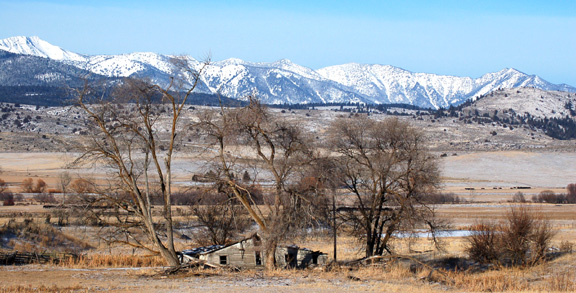CITIZEN PARTICIPATION
Now that Herald editor Mark Furman has left for academia, it will be interesting to see how the opinion page at the Herald evolves. Will they continue printing the grandiose quotes about the importance of our allegedly “free press,” i.e., the Herald, to a functional democracy in the face of their selective reporting and constrictive letters policy? (Mark Twain is supposed to have noted that “It’s a free press if you happen to own one” or something like that.)
On Thursday, April 12th, the Herald wrote that Jayson Jaycoby is now editing the opinion page--a promotion that will hopefully help he and Lisa raise the child they appear to be expecting. It was already clear from the writing style in Wednesday’s (4/11) editorial that Jayson is now on the editorial board. Judging from his statement in that Thursday’s column that he spent his first 18 summers on he West Side and will spend his 19th summer in Baker City this year, Jayson must be all of 36 or 37 years old. How reassuring! We can only hope that his ability to turn a phrase also means he is wise beyond his years. I, for one, will not be holding my breath. I have been treated to Jayson’s judgments of what is newsworthy, and my comments about growth during the citizen’s participation portion of City Council meetings, among others, are apparently not in that class.
OK, you might say, what is so special about your comments at City Council meetings? Not much perhaps, except that we do pretend to be a democracy. I am not alone in that category as many citizen’s remarks do not make the papers, even though they should. Newspaper reporters and editors have the power to decide whether your comments see the light of day, and those with power are prone to abuse it. Sure, Bill Harvey’s comments on development fees get in, but then he’s an esteemed “custom builder” representing a portion of a financially powerful industry. Twice at council meetings, in addition to my own opinions, I have cited as a source, one of the few books that explains the disproportionate costs paid by current residents for the growth that occurs in their cities and towns—costs that benefit and should be paid for by developers and new residents. That book is “Better, Not Bigger,” by Eben Fodor.
Measure 37, too, has been a contentious topic across the state for some time. Finally, 3 months after Governor Kulongoski kicked off a campaign to fix it, the Herald’s Mike Ferguson mentions it in an article yesterday. Don’t worry if you missed it though, because you won’t learn anything from Mike's article. He quotes Commission Chair Fred Warner Jr. as saying “We’ve still got 10 or 15 more. For now, this is all the staff could get done and get good reports on.” Both Mike and Brian Addison were present at the January 17th, 2007 Commissioner’s meeting where I commented on several Measure 37 demands, including one by Commissioner Fred Warner Junior himself. Not one word of the many pages of comments I gave the two reporters ended up in the paper. Measure 37 wasn’t even mentioned despite over an hour’s time being spent on it. That was the week that Kulongoski spoke on the subject, and yet, nothing about Measure 37 was worth reporting on.
We wouldn’t know from the local papers that there have been 139 Measure 37 claims, affecting thousands of acres, filed here in Baker County and that claims affecting over half a million acres have been filed in Oregon. We haven’t learned from the local papers that a poll earlier this year determined that 61% of Oregonians thought the measure should be repealed or fixed, or that 52% would vote against it if given the chance today. We haven’t been informed that most of the Baker County claimants, including Fred Warner Jr., didn’t even bother to follow the requirements of County Ordinance 2005-01, which adopted logical procedures to be followed when demanding compensation from the County. At least Commissioner Kerns made a stab at identifying the specific land use regulations he thought interfered with his right to develop property, even if James L. Kerns and Fred Warner Jr. didn’t. The ordinance, at Section 2 (7) asks for “A statement and documentation indicating the alleged reduction amount in the real property fair market value showing the difference in the real property fair market value before and then after the challenged regulation was enacted.” Few, if any applicants bothered to comply with the ordinance, and no waiver by the County was stated, so I guess we are to only selectively enforce County ordinances. When I pointed this out, I was told I could go to court, but that they were in any event going to make waivers of the requirements explicit in future reports on the claims.
My unreported message was that Measure 37 was not intended to provide huge windfalls for unsubstantiated claims seeking unlimited individual exemptions for vague uses. Most demands had not shown an actual reduction in value due to any specific regulation applied to any specific use, and given the cumulative impacts of the many M-37 claims, the citizens of this county deserve more than the anything goes free-for-all that is now occurring. They deserve a careful, thoughtful and fair administration and enforcement of County ordinances and state laws that apply to Measure 37. I spent many hours researching a contentious subject and participating in our alleged democracy. As far as the papers were concerned, the hearing didn’t even happen. (You can find the preface to my comments near the end of today’s longish blog)
Another event that didn’t happen was the Baker City Council Goal Setting Session on February 3rd, 2007. The papers didn’t report on the goals set by the new City Council. They apparently weren’t important. I read the minutes, such as they are (it wasn’t recorded to my knowledge), and went to the next Council meeting to comment because I was concerned that some of the Councilors were gearing up for a growth binge. (I hope I’m wrong about that, but the signs are that 4 or 5 of the Councilors favor fairly dramatic growth. I’m afraid that descriptions like “Vibrant” and “Bustling” are code words for long lines, congestion, blocked views, dirty air, high taxes and home prices, as well as sounds of “ka-ching” at our local merchants and realtors cash registers.) OK, so I wrote up two pages of comments and made another stab at “Citizen Participation.” Not only did the papers not report on my comments about growth, the Council didn’t even include them in the internet packet of the proceedings so that others could read them if they wished. I don’t know if that is because Mayor Petry is a realty broker/contractor whose firm advertises in the Herald, or not.
The most recent example of the Herald’s willingness to support good old American participatory democracy was there not finding room to print a letter I sent them this week opposing the burn barrel ban. I hadn’t written them a letter sind the 1st of February, or there abouts. You can find it at the end of this rant.
This sort of treatment is not just reserved for me. I know of others treated similarly, and the unifying thread seems to have three strands: 1. Don’t offend our advertisers. 2. Don’t speak out too strongly or effectively against growth and its consequences. 3. The Herald knows a whole lot more about what’s important than you or I do, after all, they are a solid and essential pillar of our “democracy.” What would we do without them???
ON OTHER MATTERS HERALD
PROCREATIONAL WISDOM FROM THE HERALD?
On Tuesday, April 10th, the Herald editorial board opined that “killing feral cats fails to address the underlying problem: procreation.” Huh??? Does the Herald know something we don’t? Do dead cats actually reanimate themselves to participate in the mating game? I know the sex drive is strong, but this sounds like another version of the second coming (no pun intended).
The recent article and editorial on “Saving a bit of Bates" was so one-sided and ill-considered that I will devote a whole future blog for it and related recreational residence issues. The Forest Service has been doing the two older women a considerable favor for years and the Herald makes it look like a case of elder abuse. Anything to make it look like you’re wearing a white hat—even if you have to turn the truth on its head.
Last Sunday was Earth Day and hundreds of thousands of people celebrated that fact. In Los Angeles, thousands came out to celebrate and paint the children’s faces. In San Diego, it was reported that more people than live in all of Baker City visited the festivities at Balboa Park during the day, where among other things, young students sold barn owl nest boxes to earth-friendly passers by. In Baker City, the Herald didn’t even report on it. They reported on some pseudo enviro group called the Water and Stream Health committee trying to find away to steal yet more water from Mother Nature. Just a few days before, the Herald was promoting Miner’s Jubillee, while ignoring the whole destructive legacy of mining in Baker County. Why don’t we celebrate Earth Day? Surely if the only local requirement is for our merchants to make a buck, they could make as much selling souvenirs of Salmon, Sage Grouse, and other imperiled species as they do phony gold nuggets and whiskey during the Jubilee.
COMMENTS NEVER TO SEE THE LIGHT OF DAY
The following are Citizen's Participation comments not reported on or printed by either the Herald or the Record-Courier:
August 15, 2006
Mayor Chuck Hofmann
Councilors Bass, Peterson, Daugherty, Haynes, Petry & Ellingson
City of Baker City
PO Box 650
1655 First Street
Baker City, OR 97814
Dear Mayor & Councilors,
I appreciate being able to voice my concerns and opinions about the proposed golf course development and about growth in Baker City.
As you know, in 1995 the citizens of Baker City overwhelmingly voted down a $600,000 tax levy to expand the golf course, but money was borrowed from the cemetery trust fund to expand it anyway. I am under the strong impression that the vast majority of Baker City residents do not use, and many cannot afford to use, the golf course facilities. Considering that most Baker City taxpayers did not want to pay for the expansion, and benefit little, if at all, from the golf course, they have surely invested enough in the golfing pleasures of those who are fortunate enough to have the money to pay the green fees. The users of the golf course should be responsible for the remaining debt.
If the city decides to enter into a scheme to sell the remaining 15 acres to developers, and I’m not convinced they should, the money from the sale should repay the cemetery trust fund first, with the remainder going into a fund to benefit all the citizens of Baker City.
If the property is developed, the property should include low and moderate-income housing units in proportion to the percentage of low and moderate-income people in Baker City, so as to reflect our economic and social diversity. We don’t need elite enclaves in Baker City, especially if the enclave’s golfing playground is financed in part by all Baker City citizens.
The cost burden created by any necessary extension of water and sewer lines, and other infrastructure to this and other possible developments, along with potential costs associated with any needed increases in water storage and sewer capacity, are the kinds of things the City apparently hopes to discuss with current residents while creating what has been termed “Comprehensive Development Policy Reform.” As noted in the discussion paper, LID non-remonstrance reform is needed, hopefully to ensure that the sort of disastrous financial pain that was inflicted on the innocent bystander, current residents adjacent to the recent Elm Street LID, is not repeated in other areas of our community.
Before we ask ourselves how we want to grow, perhaps we should ask ourselves whether we want to grow. Along with the Elm Street LID fiasco, people are beginning to notice the other negative impacts of growth, as experienced with the congestion on east Campbell Street and as will be soon be experienced by residents on “D” Street. Many of us live here because we value the quality of life provided by our small size, wide open spaces and affordable living arrangements—we don’t want to become another Bend and don’t need upscale sidewalks or curbs on every street. Most importantly, we don’t want to pay for the destruction of the very qualities of life that compel us to call Baker City our “home.” If there is such a thing as doing growth “right,” I would offer that it is growth that is well planned & controlled, recognizes population limits and local carrying capacity, pays its own way, and serves the interests of all current citizens—not just the interests of the “Growth Machine,” i.e. land speculators, developers, contractors, real estate agents, and others who directly or indirectly profit from growth. While some of you may be a part of the “Growth Machine,” you must realize that it is required for you set aside your own interests in favor of the interests of all the citizens of Baker City. Those interests include:
• improved quality of life
• better public services
• enhanced environmental quality
• protection of agricultural and resource lands
• preservation of the historic heritage, and
• economic security for current residents, including no gentrification or displacement of low income residents.
(taken in part from “Better Not Bigger;” by Eben Fodor)
If growth won’t provide these things then it should not be allowed to occur.
As always, “who benefits?” and “who pays?” are important questions. What happened to residents on “F” and Elm Streets wasn’t fair or equitable. Raising the rates for water and sewer, as has happened recently, in order squirrel away money for anticipated development driven sewer and water infrastructure upgrades, would not be a fair and equitable solution to the question of who should pay. It would be an unfair tax on current residents to benefit the “Growth Machine” and future residents. If we have reached the limits of our watershed to provide water, and the limits of our infrastructure to carry water and effluent, then perhaps we should learn to live within those limits. The burden should be on the “Growth Machine” and city officials to show why we would possibly need more development and the costly new infrastructure needed by it when the current systems serve our needs and we are content with what we have. Most of us understand that current residents invariably subsidize growth and that government too often forces us to do so when it is not in our best interests.
Perhaps the council and Baker City residents already know all there is to know about growth, but if not, there is a good, inexpensive book that the council and residents can use to understand the costs, impacts and myths associated with it. The book is “Better Not Bigger” by Eben Fodor. It can help people control growth as opposed to being controlled by it, and can help create a sustainable and very livable community. Beyond the obvious decline in quality of life often caused by growth, it explains why growth is financially costly to current residents, it explains that most jobs go to outsiders, not current residents, and it explains why growth tends to raise local taxes.
Someone once said that there are two stages of the public policy process: too early to tell, and too late to do anything about it. I hope that will not be the case in the future, and that you and the next elected city council will be open, accessible, accountable, responsive, frank, and fair with Baker City residents as you move forward with the discussion about Comprehensive Development Policy Reform.
Thank you for considering my comments.
Sincerely,
Christopher Christie
-----------------------
Preface to January 17th comments to County Commissioners
Baker County Board of Commissioners
1995 Third Street
Baker City, OR 97814
Re: Measure 37 Claim M37-06-028
Dear Baker County Commissioners:
Please accept these comments on Measure 37 Demand/Claim # M37-06-028, Fred Warner Jr.
Like many residents of Baker City and County, I live here because of the open and un-crowded conditions, the clean air and water, and the natural as well as agricultural landscapes. I enjoy the open and undeveloped agricultural areas of the County while conducting 1 to 3 raptor surveys during the fall, winter and spring months, during the spring and fall migratory bird surveys, and during the two Christmas bird counts, as well as at other times. It is encouraging to see farmland being used for one of its best uses of providing people with food and fiber, rather than for homes and other non-farm development. I also enjoy the area viewing and photographing other wildlife, wild flowers, and open landscapes. I know that unchecked development can destroy all of these important values and our quality of life in a relatively short time, as it has in so many areas in the West and elsewhere. A few decades or less is all it takes, so we have been fortunate to have sensible land use ordinances protecting our County and State since the mid-70’s.
Unchecked development in the County is already impacting the quality of life for county and city residents, and is having particularly serious impacts on Baker City in the form of congestion and the need for traffic control improvements. As you know, county development tends to destroy our quality of life in many ways. Due to the passage of Measure 37, the County had received 139 demands for compensation, covering thousands of acres, as of the end of 2006. If the County waives the applicable land use regulations for all of these demands, the increasing housing and population growth with attendant urban sprawl will:
• reduce farm, range, and timberland and other open space
• negatively impact agricultural and rural lifestyles
• deplete and potentially contaminate ground water
• increase air pollution which will result in more regulation of wood stove and automobile emissions
• damage or eliminate our views of Baker County’s magnificent landscapes
• increase traffic congestion
• increase crowding and competition for local resources like fish, game, firewood and solitude.
• increase taxes to pay for expanding county services as well as infrastructure like schools and roads.
• increasingly fragment remaining wildlife habitat and winter range, thus endangering the presence and survival of the local animal species we all enjoy
• impact sensitive environmental areas
• increase local fossil fuel use
These are just some of the reasons that land use regulations have been put in place during the last three decades or so.
With the passage of Measure 37, all of these things that many value, except for an individual’s right to make a buck off land speculation, are being seriously challenged. There is some question whether the people that voted for the measure intended to put in place a measure, that if poorly implemented, could destroy their quality of life. That is why it is important for those implementing the measure to proceed cautiously and seriouslywithin the law, and to ensure they follow both Oregon state law and Baker County ordinances when doing so. [next several pages removed]
=======================
Comments to Baker City Council
February 13th, 2007
Christopher Christie
1985 15th Street
Baker City, OR 97814
541-523-2376
refugee2000@qwest.net
Dear Baker City Councilors (Bass, Bryan, Calder, Dorrah, Duman, Petry, & Schumacher)
My Name is Christopher Christie. I live at 1985 15th Street.
At the Baker City Council Goal Setting Session on February 3rd, there was a fair amount of talk about growth. Only one of you, Mayor Petry, a building contractor and realtor, stated that they ran for office “To make sure Baker City grows,” but every one of you, and many of the City staff, mentioned growth as an important issue or something to expect in our future. Some thought we should have quite a bit of it and others talked of planning and moderation. The vision spoke to vibrancy, solid infrastructure, scheduled air passenger service, successful commercial districts, and new schools.
The problem though is that the future and the effects of growth can be surprising when all the factors affecting them are not taken into consideration or are simply ignored. People usually sell growth with a pitch that promises jobs and prosperity for all; a steak on every grill, so to speak; a cure-all for the ills of struggling communities. Your kids will get local jobs, even if you don’t have any kids or even if they don’t live here any more. But the reality can be quite different.
For starters, there didn’t seem to be a recognition that both nationally and globally, we are entering the era of decline in per capita fossil fuel energy supplies. Peak oil is happening now. In not too many years, tourist travel will become increasingly prohibitive financially, especially air travel. Our economy and our way of life will be affected, both here and elsewhere. The dysfunctional nature of the “infinite growth is good” pyramid scheme will become apparent to all as we get in touch with the finite nature of the resources we have squandered. We need to consider energy constraints and how they are going to dramatically affect our future.
And if growth does occur over the next decade or so, what will it really bring? The promise is that growth will provide jobs for your children and others in the community. Maybe, maybe not. In one study of 50 American cities, it was found that there was no statistical correlation between the growth rate and the unemployment rate—you just become a bigger, more crowded city with a similar unemployment rate. New job opportunities are not guaranteed to locals, and as you well know, many local jobs go to newcomers who are also looking for opportunities. Studies have shown that 30 to 50% of new jobs go to immigrants (Fodor, Better Not Bigger). The basic formula over a period of time is that if you double the size of your community, you will ultimately double the number of people who are unemployed. Sure it will help many realtors, contractors and small business owners, like those of you on the City Council, but it shouldn’t be sold as a promise to make jobs for locals or reduce the unemployment rate.
And then there is the issue of who benefits and who pays. There is, of course, a cost for doubling or tripling the population in order to double or triple the number of unemployed, and these costs are often hidden. Economic development and new housing, with the resultant increase in population, increases the demand for expensive infrastructure and public services. This all costs the taxpayer money and causes other kinds of grief in the form of crowding, congestion, and environmental degradation. Public subsidies are often involved, as for example the exemption from property taxes that Baker City offers certain employers. Other subsidies involve increased taxes for growth induced increases in infrastructure such as schools, sewer system and storm drain costs, water supplies and delivery, transportation, police and fire protection, garbage disposal, library service, parks and recreation, government services, etc., etc. Obviously, stable cities don’t have a need for expanded facilities, growing cities do. Growth could increase per capita charges and property taxes by hundreds of dollars annually for Baker City citizens.
Growth can also destroy, or seriously degrade, the overall quality of life for Baker City residents. The deterioration will be experienced in increased congestion, as can be seen on Campbell Street, to reduced air quality and increased regulation of wood stove heating, to increased competition for local resources like firewood and solitude, as well as in the loss of any real sense of community.
Because growth tends to be destructive of the quality of life for current residents, and is most often subsidized by them, it should be approached cautiously. If the City Council is determined to make Baker City grow, then as some of you have indicated, it should be well planned. In addition, the costs should be allocated fairly and growth should pay its own way. A new and updated community vision needs to be developed with broad citizen participation, not just with the input of City staff and the Chamber of Commerce. Community standards need to be improved to protect Baker City and our quality of life from the undesirable impacts associated with growth.
Planning should include the development of a community impact statement created by people and planners who are not conflicted by their involvement in the growth industry. It should include scenarios for what can be expected at different population sizes, and should include a no growth scenario. The public should be fully informed of the current infrastructure capacity, including water supplies, sewer system capacity, transportation grid capacity, etc. The public needs to be informed about how much of their current water and sewer charges, if any, are being used to plan and pay for increased capacity to provide for future development. We need to know how many people can be supported by current capacity and how close we are to that capacity.
To determine a fair allocation of costs between current residents and future development, a cost- benefit analysis should be done. If new facilities are needed to make development possible, then those truly benefiting from that growth should pay for it in accordance with the amount of benefit. Reductions in taxes for current residents whose lives will be negatively impacted by growth should be considered. To protect current residents and ensure that they do not have to pay for the cost of development that benefits others, system development charges and impact fees should be created for all capital improvement categories for which local jurisdictions may collect such charges and fees, as listed in ORS 223.299 (1)a. The City Council should consider a resolution asking that ORS 223.299(1) be amended to add police, fire, library, and school facilities to the list of capital improvements for which local jurisdictions may collect impact fees and system development charges.
Lastly, it is worth repeating the “Catch 22 of Growth” from Eben Fodor’s book, Better, Not Bigger. It goes like this: “The better you make your community, the more people will want to live there, until [ultimately] it is no better [and perhaps worse] than any other community.” I know that you do not want to destroy our quality of life or make current residents pay for growth that does not benefit them. I hope you will consider these suggestions to ensure that neither of these things will happen.
Thank you for listening.
Sincerely,
Christopher Christie
Many of the ideas in this letter, and much more, can be found in Eben Fodor’s Book, Better, Not Bigger.
--------------------------
April 23rd Open Letter to the City Council:
Dear Councilors,
I have read that a resident has asked that the City consider banning burn barrels, and that at the April 24 meeting, you will be expanding the discussion to open burning as well. Apparently the resident is upset that some burn some trash that is currently illegal to burn. I would request that the City not write a new law to ban a current practice, but rather enforce laws that are already in effect to remedy the problem. If people would report illegal, toxic, or otherwise offensive burning, and if the city were to send an officer out occasionally to sniff for violators, then enforcement of current law would help to curtail illegal burning. Additionally, burn barrels would appear to be safer than open burning, which is also legal and not affected by a barrel ban. I would venture a guess that all of the open and barrel burning fires in Baker City combined during a typical year would not amount to as much smoke and CO2 as is created by a single controlled burn in the forest. Allowing people to burn could also increase the longevity of the local landfill.
Composting is best, but lets not ban another current practice ala "Dogs in the park." We just need to enforce laws already on the books. Enforcement will likely jog people's memories as to what is, and what is not, legal to burn.
Sincerely,
Christopher Christie

















No comments:
Post a Comment